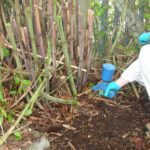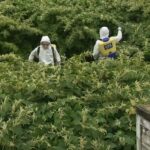
 Knotweed News
Knotweed News
How To Get Rid Of Japanese Knotweed
Author: Site Admin
Date Posted: Wednesday 27th October 2021

0161 723 2000
8AM to 5PM

Author: Site Admin
Date Posted: Wednesday 27th October 2021

What is Japanese knotweed?
Japanese knotweed is an invasive plant which attacks our gardens at will and which can seriously damage buildings and construction sites if left unchecked. It’s been in the papers so much that we’d practically need a live blog to keep up, with our efforts in raising awareness here at JKSL a big part of that. To cut a long story short, Japanese knotweed was introduced to the UK in the late 1840s, when a Dutch doctor called Philipp von Siebold came here and began to sell it to botanical gardens and high society figures in the guise of an ornamental plant, largely because it is rather nice to look out upon. Which was all well and good until the turn of the century, when the public’s perceptions of Japanese knotweed changed, and many gardeners began to regard it as a nuisance. In fact, it quickly picked up a bad reputation, starting to ‘escape’ and grow in the wild. In the 1930s, its presence was so intense that it began to reduce house prices by £100 in the geographical locations where it had started running riot. That impact of reducing house prices is still prevalent today, although we may be talking many thousands of pounds at this point, but more on that later.

It came via the aforementioned Dutchman by the name of Philipp von Siebold who brought it back to Europe around 1829. The original plant was propagated in his native Holland and marketed around Europe by Von Siebold & Company of Leiden. It was sold (notably to botanical gardens and the upper classes) principally as a decorative plant, similar in look to bamboo. Thereafter, the Victorians cherished the plant because they liked the look of it at the time; failing to appreciate what a mistake that would be for the future.


The best time to spot Japanese knotweed is during mid-summer and early autumn. During spring, reddish/purple shoots appear from the ground, readily able to grow up to 2cms a day, forming into dense stands of bamboo-like stems that develop green heart or shield-shaped leaves. However, there are a number of other plants which bear an uncanny resemblance to Japanese knotweed (such as dogwood, lilac, ornamental bistorts, Himalayan balsam, broadleaved dock and bindweed to name but a few Japanese knotweed dopplegangers). Therefore if in any doubt, we’d urge you to contact us ASAP, and we’ll send round one of our team of experts to give it a positive ID, or not, as the case may be.


We’ve all heard big claims and boasts at various times in our lives, but when it comes to debunking the myths surrounding the subject of Japanese knotweed, some go a little far. The truth is, while Japanese knotweed is an aggressive plant, it cannot shatter through concrete on its own. But before we get complacent, Japanese knotweed can make its way through concrete; all it needs to find is a hairline fracture in any surface area – which can supply the weed a direct link to both light and water – and it can begin to push on through to the other side. Over time, the knotweed will build pressure in the object it’s pushing through which can of course compromise the overall rigidity of the structure, be it concrete or otherwise. So while Japanese knotweed can’t penetrate through a solid slab of concrete per se, it can habitually make its presence felt in and around poorly laid/formed patios/driveways/block paving as well as underground sewage pipes, drains, cavity wall spaces, vents, air bricks, fences and walls. This presence can result in a range of subsequent issues from subsidence to burst water pipes.


There are a number of reasons why we think we’re the best service in the business. For starters, we’ve been at this as long as anyone, (since 2002 to be precise) with our founder, Mike Clough, leading the charge in raising awareness about the dangers of Japanese knotweed. One of the main reasons there have been stories about the plant on the BBC’s Inside Out and in various national newspapers is because of our efforts.
That said, awareness alone isn’t enough to prove our qualification. So how about the fact that we operate a team of trained and experienced professionals, are available throughout the week and around the country, offer a 100% success guarantee, can deal with commercial and domestic properties, and also invented our own technology to deal with the issue more effectively?
Basically, we have the expertise to go with our passion. It adds up to an integrity and reliability in the way we work, providing you a real peace of mind when confronted with Japanese knotweed issues and the stress and worry they can cause.
JKSL are also the founder member of INNSA, the Invasive Non Native Specialists Association. INNSA is the industry body for companies involved in controlling and eradicating invasive non-native species and aims to improve standards within the industry.


Similar to a lot of Japanese sports cars, Japanese knotweed is certainly no slouch. Whilst its 0-60 time isn’t quite comparable with that of a Nissan GT-R, it’s not that far behind. Described by the Environment Agency as ‘indisputably the UK’s most aggressive, destructive and invasive plant’, Japanese knotweed has the potential to grow 10cm a day on average (20cm at its most prolific). Within a couple of months, its stems can reach 3 – 4 metres. Underground, the rhizomes – the mass of roots – are also growing, and can spread up to 7 metres horizontally and 3 metres deep.


The one word answer to this is ‘yes’. More so if your property already has existing weak spots. Basically as the extensive network of Japanese knotweed roots grow, it will cause the soil around it to shift. So if the knotweed is located within 7 metres of a habitable space – and is causing damage to boundary walls – there’s a significant likelihood subsidence could become a factor.


It all depends on your budget, location and timeframes, but once these key factors are taken into account then there are a number of options available to you. These range from chemical or biological extraction through to traditional excavation means and our very own, bespoke MeshTech solution. Additionally, you could choose either on-site incineration or composting methods. To discuss your exacting Japanese knotweed removal requirements you should contact us today, but also feel free to take a look at our Treatments page.


No, not in the slightest. In fact, in some trendy restaurants Japanese knotweed is considered a delicacy of sorts; it appears as the core ingredient in a variety of lemony rhubarb, soups and fruit crumbles. In terms of household pets, the jury is still out, but probably best they don’t ingest.


The ideal time of year to tackle the threat posed by Japanese knotweed is during the summer months, which is essentially the period when the plant is in flower and the foliage is absorbing the most nutrients into its all-important roots. From a chemical/herbicide-based Japanese knotweed removal viewpoint, Autumn is the best time to spray the treatment directly onto the foliage. Having said that, there’s a counter argument that suggests that to afford greater access to the root cause of the problem, the winter provides the perfect window of opportunity; when the Japanese knotweed lies dormant for all intents and purpose. So, it really depends, but we’re available to provide professional advice & support on the ideal plan of action for your location.


Yes. Because as well as it posing a serious threat to the structural integrity of a property, it also throws up potential mortgage/selling issues if and when the problem is uncovered by a surveyor at any juncture in their process. It could also be your responsibility to ensure that the superweed doesn’t encroach on a neighbouring property or piece of private/commercial land.


Due to the ferocity and intensity in which it spreads, you can’t just sit back and do nothing when confronted with the spectre of Japanese knotweed. If you turn a blind eye to it, the superweed will get stronger, more difficult to treat and be more costly when it comes to the removal process. As we’ve already highlighted, it can cause extensive damage to structural work, including walls, fences, drainage systems and paving which could adjoin a neighbouring property.


As for the legalities, it’s worth noting the recent developments, because as of November 2014, ASBOs (or Community Protection notices) can now be issued to land owners with Japanese knotweed. The Anti-social Behaviour, Crime and Policing Act 2014 notice can be used to require someone to control or prevent the growth of Japanese knotweed or other plants that are capable of causing serious problems to communities. The test is that the conduct of the individual or body is having a detrimental effect of a persistent or continuing nature on the quality of life of those in the locality, and that the conduct is unreasonable. Under section 57 of the Act, that “unreasonable conduct” includes “a failure to act”.


This depends on a number of factors, including where the knotweed is sited, how dense the knotweed is and whether there are any environmental impacts on the land and surroundings. Here at JKSL, our team of Japanese knotweed experts will take all of this information into consideration before devising a treatment package, which is bespoke to your land and area. Depending on which treatment you plump for, you can expect – on average – to see a turn-around time of a matter of weeks regarding excavation and on-site incineration processes, while the chemical treatments could take 2-5 years to see full returns. A lengthy, but vital, process.


You can, but we’d never recommend it as it will always make matters worse. Even a tiny fragment of the cut rhizome (root) is capable of regeneration, which in turn can lead to a significant increase in stem density. Apparently the royal household were doing this for many years at Buckingham Palace and the knotweed still came back. Also, spreading any soil contaminated with Japanese knotweed – with contamination reaching up to 7m of the plant – could contain the highly regenerative rhizome; which will readily grow into new plants.


JKSL offer two main forms of insurance, giving you a choice of cover during and after the process. The available options are Insurance Backed Guarantees, and Performance Bonds. Beneath are brief summaries, with far more detailed information available from the team here at JKSL.


For a Domestic site: JKSL include a 10 year insurance backed guarantee (IBG) on every domestic project. This is underwritten by an insurance company and backed by the trade body INNSA. For a Commercial site: The same cover as above but for 10 years on commercial projects. Not automatically included with every project, but it is available.
JKSL Performance Bonds are the forerunner and a separate option to the IBGs. Here at JKSL, our Performance Bond runs alongside our in-house warranty (the in-house warranty includes anything from quarterly to annual inspections). This is underwritten by a leading international specialist insurance group.


Finally, we thought you’d never ask! The easiest way is to visit our Contact page for our email and phone details. We’re happy to speak to you in more detail about how we can help you with any aspect of Japanese knotweed identification, treatment and removal.

I believe I have a Japanese knotweed infestation.
How can I contact you?
